Spider-Man is hands down one of the most popular characters ever to leap from the pages of Marvel Comics, and is even a strong contender for one of the most popular comic characters produced by any comics publisher. He’s also displayed a particular trademark flexibility in successfully taking to the silver screen and flourishing through merchandizing. It may come as a surprise that it’s taken this long for a collection of scholarly essays on Spider-Man to make it onto the shelves, but it’s here at last with WEB-SPINNING HEROICS: Critical Essays on the History and Meaning of Spider-Man, edited by Robert Moses Peaslee and Robert G. Weiner, both pillars of the scholarly community when it comes to getting books and essays about comics into print, and colleagues at Texas Tech University. The field of comics scholarship is taking off at colleges and universities world-wide, introducing courses and even degrees in comics studies, prompting a need for texts about comics and models for approaching comics scholarship with attention to detailed analysis, historical context, and solid research methods.

[Dr. Robert Moses Peaslee and Robert G. Weiner. Photo taken by Isaac Villalobos, used courtesy of The Daily Toreador]
Peaslee and Weiner have quite an impressive track record in laying out that foundation for the future appreciation and celebration of comics while engaging with comics in an approachable way that can speak to the savvy fan and the graduate student alike. Their most recent project gives the Web-Slinger the attention he deserves while pondering some of the questions that have made him so fascinating for over 50 years. The essay collection WEB-SPINNING HEROICS contains contributions from over 20 scholars, ranging from both established writers to newer enthusiasts and explores topics such as Spidey’s cultural and historical context, issues of gender in Spider-Man comics, and in-depth studies of particular Spidey texts from comics to films, many of them “under-examined” by readers and scholars alike. The collection contains an impressive array of perspectives and suggests the diversity of interest out there today about Spider-Man’s ever-evolving role in the history of comics. Editors Rob Peaslee and Rob Weiner took the time to answer some questions for The Beat about their experiences putting the book together, and also on their own fascination with Spider-Man’s legacy.
Hannah Means-Shannon: What made you want to put together a Spider-Man based collection of comics scholarship? What’s your own personal history with Spider-Man comics and Spidey in pop culture?
Robert Moses Peaslee: It was really just a great opportunity for us to work together for the first time. We’d been looking for an excuse to collaborate on an edited volume, and a character like Spidey presented a perfect focus for our respective foci in comics and films. Rob’s background in comic scholarship is well known, and I’d done some analysis over superhero film characters – and Spidey in particular – previously.
Robert G. Weiner: I agree with Rob Peaslee here. It was a terrific excuse to work on something together. I’d previously done an edited volume on Captain America and with the new Spider-Man movie reboot, doing a scholarly book on the character seemed like an appropriate thing to do. I’d read a bunch of Spider-Man graphic novels while working on my Marvel Graphic Novels Annotated Guide so I was very familiar with the character and the surrounding mythos. I realized how compelling Spider-Man is as a character.
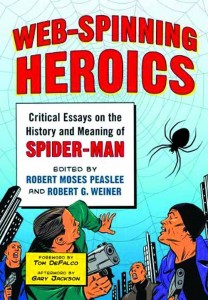
HM-S: Obviously, there was plenty of interest in participating in the collection, with over 20 essays in the book. Did the level of interest surprise you?
RP: Personally, no…I think the academy being what it is, you can do put out a call for an edited volume on the Performativity of Pancake Eating and get a fair amount of interest. And Spidey is of much greater interest in than pancakes…or almost any other pop culture icon for that matter. I’d say he’s top-10 globally in terms of most recognizable fictional characters.
RW: No, the level of interest was not surprising! I consider Spider-Man to be one of the big three of the most recognizable sequential art characters in the world (those being Batman, Superman, and Spider-Man). The one thing I was disappointed with was that we didn’t get much in the way of extended Spidey family Universe analysis (Spider-Woman, Spider-Girl, Cosmic Spider-Man, Spider-Man 2099, Scarlett Spider etc.). By the way, I consider Tom DeFalco’s writing on Spider-Girl to be some of the best comics writing period. That series was great.
We do have some well-known contributors working in the field of sequential art scholarship, media studies, film, education, journalism, business, and history among others.
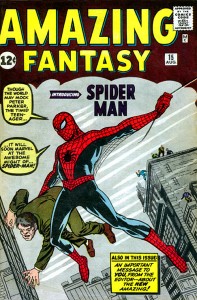
HM-S: Does Spider-Man, or other mainstream, long-running superheroes get enough attention in comics scholarship? What do you see as still needed when addressing super-heroes in comics scholarship?
RP: From my perspective, the big black hole in sequential art study is engagement with the audience…what meaning is derived from these forms, characters, and narratives? How do readers/viewers/gamers incorporate them into their sense of self, worldview, etc.? Spider-Man, as a character ostensibly “more like us” than his superhero colleagues, would seem especially pertinent in this regard.
RW: I agree with Rob Peaslee here. One of the important questions to answer is how have the comic companies producing superhero “products” engaged with their audience historically? While there are good works out there on comic culture, there is still so much related to fandom that could be studied and understood from all kinds of angles. Comic conventions are a goldmine for scholars wanting to see how superheroes have impacted our ethos. What causes someone to dress up like Spidey, Batman, Green Lantern, the Flash or villains like, Poison Ivy, Bane, Doc Ock, Green Goblin, Venom? Is it more than just fun? There is something that fans identify with in the character that it becomes personal.
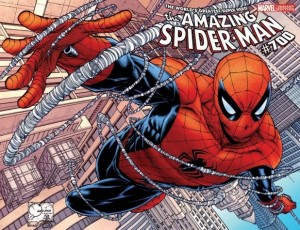
HM-S: The book has a foreword by Tom DeFalco. What was his reaction when you initially approached him about putting together the collection?
RW: Actually, one of our contributors was corresponding with J.M. DeMatteis, and somehow Tom De Falco found out through J.M. about the project. He contacted me initially. We are so grateful he contributed and gave his blessing to the project. I consider him one of the best (along with J.M. of course) in the long line of Spidey scribes. He was a delight to work with. It is always nice to have someone who has actually written or drawn the character get involved with an academic tome like ours.
HM-S: I have seen WEB-SPINNING HEROICS on the shelf in comic book shops. Do you think casual comic fans are likely to pick it up? Would it be accessible for all levels of readership?
RP: Most of it, yeah. There are a few essays that deal with some pretty formidable theory, but that’s as it should be. Spider-Man and his universe tap into some areas that we believe require some substantially sophisticated thinking to truly unpack. But we built the book to have something for the fans, the creators, the historians, and the scholars. Hopefully, that comes through.
RW: Yes I think there is enough there that all types of readers could get something from the volume. As Rob Peaslee says, there are a few weighty pieces in the volume, but there is also material anyone into Spidey could enjoy.

HM-S: Why do you think Spider-Man comics have endured so long in the popular imagination and in print?
RP: I think it’s the radical reliability of Peter Parker. Spider-Man is the disguise that enables him to be the Peter he feels he needs to be in order to live authentically.
RW: I agree with Rob Peaslee here. Peter Parker really was a different kind of superhero and the character resonated with the comic reading public in 1962-63. Peter/Spider-Man has never really waned since then. Despite having this “wonderful” power, Peter has lots personal problems and angst (and continues to do so). The supporting characters are all interesting and the villains are fascinating. Whether in red/blue, black, or even white, the Spidey costume is just plain cool.
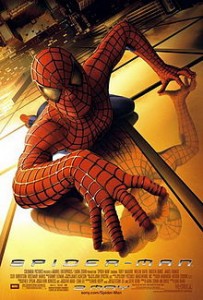
HM-S: Why do you think Spider-Man has translated so well to the silver screen? What do you think film versions bring to Spider-Man mythology?
RP: Clearly, superhero texts are tailor-made for film. There’s the hero’s journey story-structure that fits so well in the dominant American cinematic mode of three-acts and climax. There’s the potential for fantastical or sci-fi-driven storylines that both maximize Hollywood’s potential for creating CGI and satisfy the audience’s desire for escape and spectacle. But what’s made Spider-Man and Batman successful on screen to a much greater degree than their peers, I think, is their flaws, which lead to much more compelling character arcs. People think they’re going for the explosions and the web-slinging, but what ultimately brings them value is a compelling inner story.
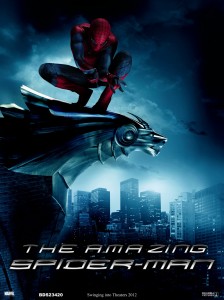
RW: I think the technology has gotten up to speed to make a believable Spider-Man movie. One only has to compare the 1970s live action Spider-Man television series with the films to see the difference. One of the things that the Spider-Man films have done right is the seamless way they combine CGI with live action. When Spidey is bouncing around New York it looks good and not “cheesy.” (Grant Morrison said it was “dreamlike”). One of the big problems with the Hulk films is that the audience is always aware it is watching a big green CGI creature and it looks that way. The Avengers did the best version of the character so far As Rob Peaslee mentions above, the “inner story” is what is compelling about Spider-Man. The relationships he has with the supporting characters combined with the villains.
HM-S: Rob Weiner, what motivated you to write about the romance between Peter Parker/Spider-Man and Mary Jane for the collection? Why did this relationship catch your attention particularly?
RW: Well I’ve always been fascinated by the concept of romance in superhero comics. For example, a lot of readers don’t realize that even Professor X once considered Jean Grey a “love” interest when she first joined the X-Men (along with the other X-guys). In particular, those early Marvel stories usually written by Stan Lee always had this anxiety concerning romance. Matt Murdock and Foggy always pining for Karen, Peter Parker getting turned down on dates, Sub-Mariner always chasing Sue Storm, Captain America always keeping his distance, Wasp/Janet always flirting with all the other heroes in her attempts to get Hank/Ant-Man’s attention.
Spider-Man presents an interesting case. I had original thought of the concept for the 2010 Film & History conference which had romance as its theme. One of the reasons the Spider-Man movies are so successful is that at their core the films are romances rather than action films. The opening narration in the first film sets this up as Parker discusses his love for Mary Jane. I thought it would be interesting to compare and contrast the three films with three important events in their relationship from the comics from different eras. I found it amusing that Parker was always trying to avoid meeting Mary Jane in those early comics (which was a great plot device). In both the comics and films Mary Jane is a strong woman who demands respect, equality, and Peter’s loyalty. Even though in all of the films she gets taken by the villain and Spidey has to rescue her, she knows the risks of being Spider-Man’s partner and accepts it. She makes the choice despite the danger. I also thought it would be interesting to explore from the comics the marriage and subsequent erasing of their relationship. Peter Parker/Spider-Man doesn’t often get a “break” when it comes to romance, but there have been a few moments of happiness and joy.
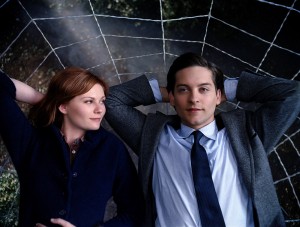
HM-S: Rob Peaslee, what do you think that psychoanalysis can bring to an understanding of Spider-Man comics or Peter Parker/Spider-Man particularly? Why did you choose this topic to explore in the collection?
RP: This article was actually a reprint of a piece I published in a journal several years ago, and Rob Weiner convinced me that it had a place here. I think psychoanalysis is a rich theoretical framework not only for approaching Spidey, but for understanding the structure, content, and reception of the superhero text more generally. It’s not the only way to look at the superhero, obviously, but when we consider Freud’s ideas about the id, wish-fulfillment, degradation, etc., it’s hard not to see these notions on display in nearly every superhero story.

[A psychologically transforming moment in AMAZING FANTASY #15]
HM-S: What other heroes or topics could benefit from further study and discussion these days?
RP: Funny you should ask, Hannah! We’re working on another collection about a prominent character from the comics universe, but as that is under review right now and we don’t want to steal our own thunder just yet, we’ll have to leave you to speculate.
RW: Oh I think the field is STILL wide open. There is so much history and many heroes and villains that deserve the academic treatment. As I’ve argued before, I see comics as a form a social history. They are documents of the time in the same way movies and novels are. I’d love to see more analysis of the darker heroes like Spawn, Punisher, The Demon, Ghost Rider, Blazing Skull, Creeper, Deadman, Man Thing, Sub-Mariner, Moon Knight, Deathlok, and the Phantom Stranger not to mention those wacky superhero stories from the 1950s. I know there has been scholarship on these characters but there is always room for more. So much comics scholarship focuses on the last 30 years, but as someone trained as a historian, I like to know what do the earlier (Golden Age) comics say about our world past and present?
HM-S: What got you into comics scholarship and writing about comics?
RP: I came in the back door, as it were, from the movie theater. I’ve only recently begun reading comics…in fact, I’ve probably read more scholarship about comics than I’ve read actual comics. Rob Weiner has been a significant mentor in this regard.
RW: Comics have always been a part of my life off and on since I was a little. I started to write and study comics while I was working as a public librarian over 15 years ago. I started obtaining graphic novels for the library collection and began reading them. I wrote an article about collecting graphic novels for the Texas Library Journal and then it just took off from there. However, I always thought there was something “deeper” in sequential art storytelling. When I first read WATCHMEN in 1990, I remember thinking this could be used in a philosophy or political science class. I spent six years reading and writing for the Marvel Graphic Novels Annotated Guide, which was my trial by fire.
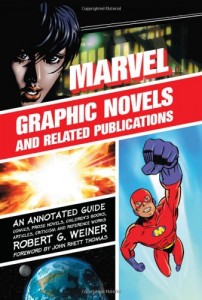
HM-S: Are there any upcoming projects you’re working on that you all would like to spread the word about?
RP: The piece we’re working on fills a void in the scholarship so large and obvious, that until we’re under contract, we don’t want to say too much. Somebody else might slap their forehead and beat us to it. Stay tuned…
RW: Ditto above! I do have a volume that I co-edited with my librarian colleague Carrye Syma on the educational power of sequential art (Comics and Education) forthcoming from McFarland.
HM-S: Flipping through WEB-SPINNING HEROICS, I have to confess, opened my eyes to how many great topics are worth discussing in-depth when it comes to Spider-Man, and also made me think of new directions for exploring Spider-Man as a cultural phenomenon. That’s certainly the role of good scholarship, providing springboards for the imagination of readers, so thanks for the tireless work, Rob Peaslee and Rob Weiner, in putting the collection together. Looking forward to all your mysterious projects yet to come documenting the role and significance of comics!
Hannah Means-Shannon writes and blogs about comics for TRIP CITY and Sequart.org and is currently working on books about Neil Gaiman and Alan Moore for Sequart. She is @hannahmenzies on Twitter and hannahmenziesblog on WordPress.
 Archie Comics plans to conclude the original Archie series with the release issue #666.
Archie Comics plans to conclude the original Archie series with the release issue #666.

















